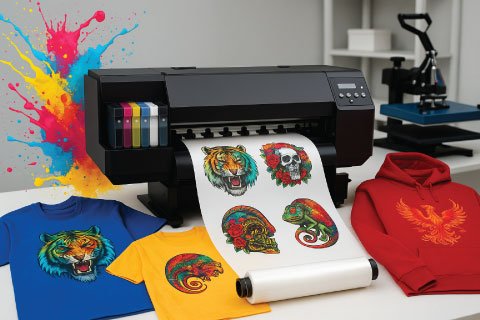In the fast-evolving world of custom apparel and printing technology, Direct to Film (DTF) printing has emerged as a game-changer for businesses and hobbyists alike. If you’re considering adding DTF printing to your project lineup or switching from other printing methods, understanding the ins and outs of DTF is essential to making the best choice for your needs.
This ultimate guide dives deep into how to choose DTF printing for your projects, covering everything from the technology behind DTF to selecting the right materials, printers, inks, and vendors. Whether you’re a small business owner, custom apparel creator, or a printing enthusiast, this guide will help you unlock the full potential of DTF printing in 2025.
What Is DTF Printing?
Direct to Film (DTF) printing is a modern, versatile method for applying full-color designs to garments and other textiles. Unlike Direct to Garment (DTG), which prints directly onto fabric, DTF prints designs onto a specialized film first, which is then heat pressed onto the material using adhesive powders. This process allows for crisp, vibrant designs on a wide range of fabrics—including cotton, polyester, blends, and even non-textile surfaces.
Why DTF Printing?
- Versatility: Works on multiple fabric types and colors without the need for pretreatment.
- Durability: Prints last longer with excellent wash fastness and resistance to cracking or peeling.
- Cost-Effective: Ideal for short runs and one-off designs without the high setup costs of screen printing.
- Vibrant Colors: High-quality prints with vivid details and smooth gradients.
If you’re exploring the best printing method for your apparel or merchandise projects, DTF printing is a strong contender thanks to its flexibility and quality.
Assess Your Project Needs
Before diving into DTF printing, clarify your project requirements. Here are essential questions to guide your decision:
- What type of materials will you print on?
Are you working primarily with cotton, polyester, blends, or unusual materials like nylon or leather? DTF works well on most fabrics, but knowing your substrate will help you select the right adhesive and film type. - What is your order volume?
DTF printing excels for short to medium runs, especially when you want high-quality, full-color designs without the setup fees of screen printing. For bulk large orders, you might consider screen printing depending on costs. - Do you need vibrant colors or complex designs?
DTF supports rich gradients, detailed artwork, and multiple colors without increasing costs significantly, making it ideal for custom, multi-color projects. - What is your budget?
Initial investment in DTF equipment and supplies can vary. For small businesses, outsourcing DTF printing to vendors like DTFSuperPrint.com might be more economical. - What is the expected durability of your prints?
DTF prints offer excellent wash resistance, making them suitable for items needing frequent washing, such as sportswear or kids’ clothing.
Understanding the DTF Printing Process
To choose the right DTF solution, you need to understand the workflow:
- Design Creation: Digital artwork is prepared in software like Adobe Illustrator or Photoshop. Designs must be optimized for transparency and color profiles.
- Printing on Film: The design is printed in reverse on a PET film using DTF inks (CMYK plus white ink). The white layer serves as an opaque base for colors.
- Powder Application: A hot-melt adhesive powder is evenly applied to the wet ink on the film.
- Curing: The powder is cured by heating, bonding it with the printed design on the film.
- Heat Press Transfer: The film is heat pressed onto the garment, melting the adhesive powder and fusing the design to the fabric.
- Peeling: After cooling, the film backing is peeled off, leaving the printed design on the garment.
Knowing this process helps you evaluate the quality and consistency of DTF prints.
Key Advantages of DTF Printing
Before making your choice, here’s why DTF printing is gaining massive popularity:
- Wide Fabric Compatibility: Unlike DTG, DTF doesn’t require pretreatment and works on dark, light, and synthetic fabrics.
- High Resolution & Color Range: Achieve detailed prints with vibrant colors and smooth gradients.
- Flexibility in Order Size: Perfect for one-off orders, small batches, or on-demand printing without high setup fees.
- Durable and Wash-Resistant: Prints resist cracking, peeling, and fading through multiple washes.
- Cost-Effective: Lower cost per print for complex, multi-color designs.
- No Color Restrictions: Can print unlimited colors without extra cost, unlike screen printing.
Choosing the Right DTF Printer
Selecting the right DTF printer is crucial to achieving your desired quality and production volume. Here are factors to consider:
Printer Type
- Industrial DTF Printers: Best for high-volume production with faster print speeds and larger print areas.
- Desktop DTF Printers: Ideal for small businesses and hobbyists with moderate volume needs.
Print Quality
Look for printers with a minimum 1440 dpi resolution for sharp, vibrant prints. Consider machines that support white ink circulation systems to prevent clogging and maintain print quality.
Ink Compatibility
DTF printers use specialized water-based pigment inks. Ensure the printer supports high-quality, durable inks designed for DTF applications.
Ease of Use & Maintenance
Choose printers with user-friendly software and low-maintenance features to reduce downtime. Automated cleaning systems are a plus.
Cost & Warranty
Balance your budget with features, print quality, and vendor support. Some printers offer warranties and training to help you get started.
Best Materials for DTF Printing
DTF printing works well with various materials, but here’s what to look for:
- Fabrics: Cotton, polyester, cotton-poly blends, nylon, and leather can all be printed using DTF.
- Colors: Both dark and light fabrics work well since white ink underlayers improve color vibrancy on dark fabrics.
- Adhesive Powders: Use high-quality hot-melt adhesive powders to ensure prints adhere strongly and last through washes.
- Films: PET films specifically designed for DTF printing offer excellent ink adhesion and release properties.
Inks & Adhesives — What to Choose?
Quality inks and adhesives affect your final product durability and look.
- DTF Inks: Pigment-based inks provide vibrant colors and excellent wash resistance. Avoid cheap inks that fade or crack.
- White Ink: Essential for opacity, especially on dark garments. Make sure your printer supports white ink circulation to keep consistency.
- Adhesive Powder: Opt for premium powders that cure well and bond strongly with fabric and ink. Powder particle size affects print feel — finer powders result in softer prints.
Post-Printing Considerations
The printing process doesn’t end when the image is printed on film. Here’s what matters afterward:
- Heat Press Settings: Proper temperature, pressure, and pressing time are critical for optimal adhesion. Typically, 160-170°C for 15-20 seconds is standard.
- Peeling Technique: Cold peel films prevent print distortion; warm peel might work for certain materials but requires experience.
- Washing Instructions: Educate your customers on washing inside out, cold water, and low heat drying to prolong print life.
When to Outsource DTF Printing
If investing in DTF equipment is beyond your budget or time constraints, outsourcing is a smart option. Here’s when to consider DTFSuperPrint.com or other professional vendors:
- Low Volume or Custom Jobs: Save costs by ordering print-on-demand instead of bulk inventory.
- Testing New Designs: Outsourcing lets you test market demand without upfront printing costs.
- Lack of Equipment or Expertise: Leave complex processes to experienced professionals for quality assurance.
- Faster Turnaround: Vendors often have industrial printers capable of faster production and consistent quality.
Outsourcing to reputable DTF providers can elevate your product quality and brand reputation.
Common Mistakes to Avoid When Choosing DTF Printing
To get the best results, steer clear of these pitfalls:
- Ignoring Fabric Compatibility: Not all fabrics are equally suited for DTF—check material specs carefully.
- Using Low-Quality Inks or Films: Cheap consumables can ruin prints and reduce durability.
- Improper Heat Pressing: Incorrect temperature or pressure settings cause poor adhesion or print damage.
- Overlooking White Ink Maintenance: White ink clogs cause print defects—ensure proper printer care.
- Neglecting Customer Instructions: Inform end-users about washing and care to maintain print longevity.
How to Maximize Your ROI with DTF Printing
DTF printing offers tremendous business opportunities. Here’s how to maximize your investment:
- Offer Customization: Personalization drives demand. Use DTF to create one-off custom pieces quickly.
- Expand Product Range: Print on a variety of garments and accessories — hats, bags, scarves, etc.
- Leverage Online Sales: Use eCommerce platforms with print-on-demand DTF services to reduce inventory risks.
- Bundle Products: Combine DTF printed apparel with complementary products for higher-value sales.
- Stay Updated: Keep up with advances in inks, powders, and printers to improve quality and reduce costs.
Why Choose DTFSuperPrint.com for Your DTF Printing Needs?
At DTFSuperPrint.com, we specialize in providing top-tier DTF printing solutions tailored to your unique project requirements. Here’s why we stand out:
- Premium Quality Materials: We use only industry-leading inks, films, and powders for vibrant, durable prints.
- Fast Turnaround: Our streamlined production process ensures timely delivery, no matter your order size.
- Competitive Pricing: Affordable rates that cater to startups and large orders alike.
- Expert Support: Our team helps you optimize your designs and printing process for best results.
- Wide Product Range: From apparel to promotional items, we print on a variety of substrates.
Choosing DTFSuperPrint.com guarantees your projects get the professional quality and reliability they deserve.
DTF printing is revolutionizing the custom apparel industry with its versatility, quality, and cost-effectiveness. Whether you’re a small business owner or a creative entrepreneur, choosing the right DTF printing approach can unlock new opportunities and elevate your brand.
By understanding your project needs, selecting the right equipment, inks, and materials, and following best practices, you’ll maximize your success with DTF printing in 2025. For those looking to outsource, partnering with trusted experts like DTFSuperPrint.com ensures exceptional results without the hassle of equipment investment.
Take advantage of the latest in DTF technology and start creating vibrant, durable custom prints today!

